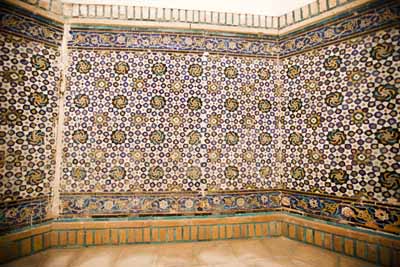On the other side of the square from the Kalon Minaret and Mosque is the Mir-i-Arab Madrassa, built around 1535. The Shaybanid ruler Ubaydullah Khan reportedly used his share of the money from the sale of 3,000 Persian slaves to finance its construction. The project was carried out by Sayyed Mīr ʿAbd-Allāh, a Sufi shaikh from the Yemen (some sources say from Sayram in what is now Kazakhstan—take your pick) who arrived to Bukhara around 1515 and became Ubaydullah Khan’s friend and spiritual advisor. The finished madrassa became known as Mīr-i-Arab, another version of Sayyed Mīr ʿAbd-Allāh’ name.
The madrassa was active from its founding until the 1920s. Only Arabic language was used in the study of theological subjects. Mathematics and the sciences were not encouraged and anyone caught reading secular history, literature, or poetry was immediately shown the door. The madrassa was closed down in 1926 and not reopened until 1946, when Stalin decided to placate the Uzbek people by throwing then a few bones of religious freedom. The madrassa is currently active and hosts a hundred or more students who pursue studies in Arabic language and theology.
Mir-i-Arab Madrassa
Entrance to Mir-i-Arab Madrassa
Entrance to Mir-i-Arab Madrassa
Decoration of facade
The tomb of Sayyed Mīr ʿAbd-Allāh’—Mir-i-Arab—is in a room just to the left inside the front entrance. The tomb of his patron Ubaydullah Khan is just behind it.
Decoration in Tomb Room. Reportedly it is the original and not restored.
Detail of decoration in Tomb Room
MIr-i-Arab Madrassa at night
MIr-i-Arab Madrassa at night
MIr-i-Arab Madrassa at night. A curious optical illusion is created whereby the entranceway looks convex instead of concave.














No comments:
Post a Comment